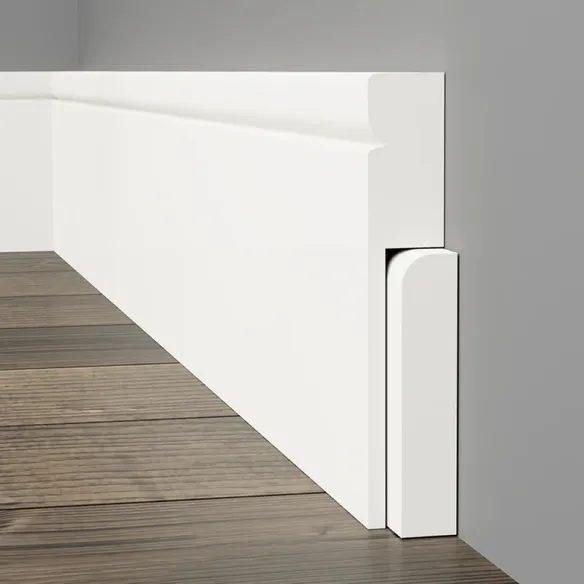The prospect of transforming a room with ready-made wall panelling is exciting. While the kits are designed for simplicity, a meticulous approach is the key to achieving a flawless, professional-looking result. Follow this detailed step-by-step guide to ensure your installation is smooth and successful from start to finish.
Phase 1: Preparation is Everything
A perfect finish begins long before the first panel is ever touched.
Step 1: Gather Your Tools and Materials
Having everything at hand prevents mid-project frustration. You will need:
-
The Panelling Kit: Ensure all pieces are present and undamaged.
-
Adhesive: A high-quality construction adhesive (often provided in the kit).
-
Measuring Tools: Tape measure, a long spirit level (at least 2 feet), and a pencil.
-
Cutting Tool: A fine-toothed handsaw or a jigsaw with a fine blade for clean cuts.
-
Application Tool: A caulking gun for the adhesive.
-
Fixing Tools: A nail gun with finishing nails OR a hammer and nail punch (optional, but recommended for extra hold).
-
Finishing Supplies: Painter’s tape, paintable latex caulk, wood filler, a putty knife, sandpaper, primer, and paint.
Step 2: Prepare the Wall Surface
-
Clear the Room: Remove furniture, artwork, and outlet covers from the wall.
-
Clean the Wall: Wipe down the wall with a damp cloth to remove any dust or grease. A clean surface ensures the adhesive will bond properly.
-
Repair and Smooth: Fill any significant holes or cracks with spackling. While pannelling kit can hide minor flaws, a relatively flat wall is crucial for the panels to sit flush without gaps.
Step 3: Plan and Mark Your Layout
This is the most critical step to avoid crooked panels.
-
Find Your Starting Point: Don’t assume your ceiling or floor is perfectly level. Use your spirit level to draw a faint, perfectly vertical plumb line on the wall where you plan to install your first panel.
-
Map it Out: If you are installing multiple panels or a grid pattern, use the level and pencil to lightly mark the entire layout on the wall. This visual guide will help you maintain consistent spacing and alignment as you work.
Phase 2: The Installation Process
Now for the main event. Work methodically and check your alignment constantly.
Step 4: Apply the Adhesive
-
Use the Right Pattern: Apply a generous, wavy or zig-zag line of construction adhesive to the back of the first panel. Avoid applying it too close to the edges, as it will squeeze out when pressed.
-
Pro Tip: For larger panels, consider adding dabs of adhesive in the center as well to prevent bowing.
Step 5: Position and Secure the First Panel
-
Align Carefully: Press the panel firmly onto the wall, aligning its edge with the plumb line you drew.
-
Check for Level: Immediately place your spirit level against the face of the panel to ensure it is perfectly vertical and straight. Do not rely on the panel’s own edge.
-
Temporary Support: Use painter’s tape to hold the panel in place while the adhesive sets, especially if you are not nailing.
-
For Added Security: If using a nail gun, fire a few finishing nails through the panel (ideally into the wall studs) at a slight angle. This is called “toe-nailing” and provides immediate, strong hold while the adhesive cures. Sink the nail heads slightly below the surface.
Step 6: Continue the Process
-
Work Methodically: Move on to the next panel, butting it tightly against the first. Use a small spacer (like a piece of cardboard) if the kit requires a specific gap for shadow lines.
-
Check and Re-check: After installing each panel, use your level to ensure it is aligned with the previous one and your original layout marks. A small error early on can compound into a large, visible mistake later.
Step 7: Handle Obstacles and Cuts
-
For Electrical Outlets or Light Switches: Turn off the power at the circuit breaker. Carefully measure and mark the location of the outlet on the panel. Use a jigsaw or drill to create a precise cutout before installing the panel.
-
For Trimming to Fit: When a panel needs to be shortened to fit at the end of a wall or around a corner, measure twice and cut once. Use a fine-toothed saw to ensure a clean, splinter-free edge.
Phase 3: The Finishing Touches
This phase is what separates a good DIY project from a great one.
Step 8: Fill and Caulk
-
Fill Nail Holes: Use a small amount of wood filler to cover any nail holes or minor gaps at the joints. Wipe away excess immediately with a damp cloth for a smooth finish.
-
Caulk the Edges: Run a thin, continuous bead of paintable latex caulk along the top, bottom, and side edges where the panelling meets the wall or ceiling. Use a damp finger or a caulking tool to smooth the bead, creating a seamless transition. This step is crucial for a built-in, professional appearance.
Step 9: Sand and Paint
-
Light Sanding: Once the filler and caulk are completely dry, lightly sand any filled areas and the entire surface of the MDF panels with fine-grit sandpaper (if they are unprimed). This ensures a perfectly smooth surface for painting. Wipe away all dust with a tack cloth.
-
Prime: This step is non-negotiable for MDF. Apply a high-quality, solvent-based or shellac-based primer. This seals the MDF, prevents the paint from being absorbed unevenly, and blocks any potential tannin bleed. Pay special attention to any cut edges, as these are the most porous.
-
Paint: Finally, apply two thin coats of your chosen paint—a satin or semi-gloss finish is ideal for durability and easy cleaning. Use a roller for large, flat areas and a high-quality brush to cut in around the edges and details.
By following these detailed steps, you can move forward with confidence. The process is straightforward, but patience and precision are your greatest allies. The moment you add the final coat of paint and step back to admire your work, you’ll see a space that has been fundamentally elevated by your own skill and effort.

